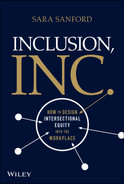Language Guide
Readers will come to this book with varying levels of diversity, equity, and inclusion (DEI) vocabulary. The dialogue around DEI is continuously evolving, and words can have different meanings for different people. This brief guide provides a common language framework for the rest of the book. It is not intended as a glossary, but rather to clarify how DEI language is being used in Inclusion, Inc.
Black
Why is “Black” capitalized in this book, but not “white,” when referring to race?
In July 2020, the New York Times announced that, after a month of discussion, they would capitalize Black when describing people and cultures of African descent.1 Hundreds of news organizations, including the Associated Press, made the same choice in the spring and summer of 2020. Most news organizations have declined to capitalize “white” because it is an identifier of skin color, rather than of shared experience.
For the reasons stated by these organizations, I have chosen to capitalize “Black” and not “white” when referring to race in Inclusion, Inc.
DEI
The term “DEI” stands for diversity, equity, and inclusion. In this book, it is used to refer to the field of work that focuses on ensuring that employees of all backgrounds—especially underestimated backgrounds—are included, treated fairly, and given the same opportunities to advance as their peers.
Diversity. The presence of individuals who differ from one another in a range of ways, such as socioeconomic status, age, gender identity, ethnicity, race, language, and religion.
Equity. Fairness of treatment for employees of all backgrounds. The distinction between equity and equality is important: Equity does not mean equal treatment, but rather creating equal access to opportunities through equitable practices.
Inclusion. Moving beyond recruiting underestimated individuals to involving them in decision-making and valuing and rewarding their contributions. One of my favorite definitions of inclusion came from DEI expert Verna Myers: “Diversity is being asked to the party. Inclusion is being asked to dance.”
Intersectionality
How class, race, age, gender, sexual orientation, and other aspects of identity “intersect” with one another or overlap. For example, the experiences of being Latinx or being a woman are not the same as being Latinx and a woman. Certain biases are only experienced when living at the intersection of these two identities.
Neurodivergent
Refers to individuals who experience different neurological functioning than the majority of the population. Neurodivergence may present as autism, attention deficit disorder, dyslexia, dyspraxia, Tourette syndrome, or in a number of other forms.
Underestimated
Why is the term “underestimated,” rather than “underrepresented,” used to refer to individuals and groups that experience bias in the workplace?
In 2015, Arlan Hamilton founded the Los Angeles–based venture capital firm, Backstage Capital, to invest in “underestimated founders,” including founders of color, women, and those who identify as LGBTQ. She also used the term “underestimated” in the title of her book, It's About Damn Time: How to Turn Being Underestimated into Your Greatest Advantage.
I wanted to adopt this term because in many cases, I believe it is more accurate than “underrepresented.” For example, “underrepresented” is not accurate when women make up over half of a group. Although they may not be underrepresented, they remain underestimated.
When you see the term “underestimated” throughout this book, I am using it to refer to groups that have historically experienced systemic bias toward a facet of their identity, such as race, gender, age, nationality, disability status, or other characteristic that is not considered the “default.” I think this term better reflects the untapped potential of these groups.
I still use the term “underrepresented” occasionally, when it is a contextually accurate descriptor of the group or individuals being discussed.
Note
- 1. John Eligon, “A Debate Over Identity and Race Asks, Are African-Americans ‘Black’ or ‘black’?” New York Times, June 26, 2020, https://www.nytimes.com/2020/06/26/us/black-african-american-style-debate.html.
